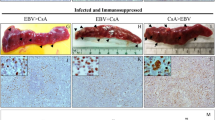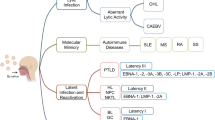Abstract
Serological and molecular biological studies1–3 have shown an association between Epstein–Barr virus (EBV) and naso-pharyngeal carcinoma. Although it has been shown that the epithelioid tumour cells carry EBV genomes4, they are apparently devoid of receptors for EBV (H.W., unpublished observations). Others have suggested that fusion of EBV carrying cells with epithelial cells may be the mode of entry of the virus into cells unable to absorb the virus and that this may be mediated by one of the known syncytium-forming viruses which inhabit the respiratory tract (for example, members of the paramyxovirus group), de Thé and colleagues suggested that intercellular bridges could be seen in NPC tumour material5. We have developed a technique which permits the preparation of stable monolayers of viable human lymphoblastoid cell lines6. Using this technique we have now demonstrated that EBV can induce fusion between EBV-superinfected lymphoblastoid cells and cells devoid of EBV receptors.
This is a preview of subscription content, access via your institution
Access options
Subscribe to this journal
Receive 51 print issues and online access
$199.00 per year
only $3.90 per issue
Buy this article
- Purchase on Springer Link
- Instant access to full article PDF
Prices may be subject to local taxes which are calculated during checkout
Similar content being viewed by others
References
Old, J. et al. Proc. natn. Acad. Sci. U.S.A. 56, 1699–1704 (1966).
Henle, W. et al. J. natn. Cancer Inst. 44, 225–231 (1970).
Wolf, H., Werner, J. & zurHausen, H. Cold Spring Harb. Symp. quant. Biol. 39, 791–796 (1974).
Wolf, H. et al. Med. Microbiol. Immun. 161, 15–21 (1975).
Gazzolo, L., de Thé, G., Viullaume, M. & Ho, H. C. J. natn. Cancer Inst. 48, 73–86 (1972).
Bayliss, G. J. & Wolf, H. in Advances in Comparative Leukemia Research (eds John, D., Lapin, B. & Blakeslee, J.) 381–382 (Elsevier, New York, 1979).
Yajima, Y. & Nonoyama, M. J. Virol 19, 187–194 (1976).
Bayliss, G. J. & Nonoyama, M. Virology 87, 204–207 (1978).
Henle, W. et al. Science 169, 188–190 (1970).
Seigneurin, J-M., Vuillaume, M., Lenoir, G. & de Thé, G. J. Virol, 24, 836–845 (1977).
Döhnert, G. in Sitzungsbericht der Heidelberger Akademie der Wissenschaften Vol. 3 96–168 (Springer, Berlin, 1977).
Wolf, H., Wilmes, E. & Bayliss, G. J. in Modem Trends in Leukemia Vol. 4 (Springer, Berlin, in the press).
Wolf, H., zurHausen, H. & Becker, V. Nature new Biol. 244, 245–257 (1973).
Ooka, T., Lenoir, G. & Daille, J. J. Virol 29, 1–10 (1979).
Hampar, B. et al. Nature new Biol. 244, 214–217 (1973).
Nonoyama, M. & Pagano, J. S. Nature new Biol. 233, 103–106 (1971).
Finerty, S. et al. Br. J. Cancer 37, 231–239 (1978).
Author information
Authors and Affiliations
Rights and permissions
About this article
Cite this article
Bayliss, G., Wolf, H. Epstein–Barr virus-induced cell fusion. Nature 287, 164–165 (1980). https://doi.org/10.1038/287164a0
Received:
Accepted:
Issue Date:
DOI: https://doi.org/10.1038/287164a0
This article is cited by
-
Epstein Barr virus associated smooth muscle tumors in the central nervous system: a case report and systematic review of the literature
Journal of Neuro-Oncology (2020)
-
Epstein–Barr virus gene expression in human breast cancer: protagonist or passenger?
British Journal of Cancer (2003)
-
Analysis of Epstein-Barr viral genomes in lymphoid malignancy using southern blotting, polymerase chain reaction and in situ hybridization
Virchows Archiv B Cell Pathology Including Molecular Pathology (1990)
-
Ultrastructural studies on cell fusion induced by Epstein-Barr virus or N-butyrate and 12-O-tetradecanoylphorbol-13-acetate
Archives of Virology (1985)
-
The expression of Ia-antigen on nasopharyngeal carcinomas xenografted into nude mice
Archives of Oto-Rhino-Laryngology (1985)
Comments
By submitting a comment you agree to abide by our Terms and Community Guidelines. If you find something abusive or that does not comply with our terms or guidelines please flag it as inappropriate.



